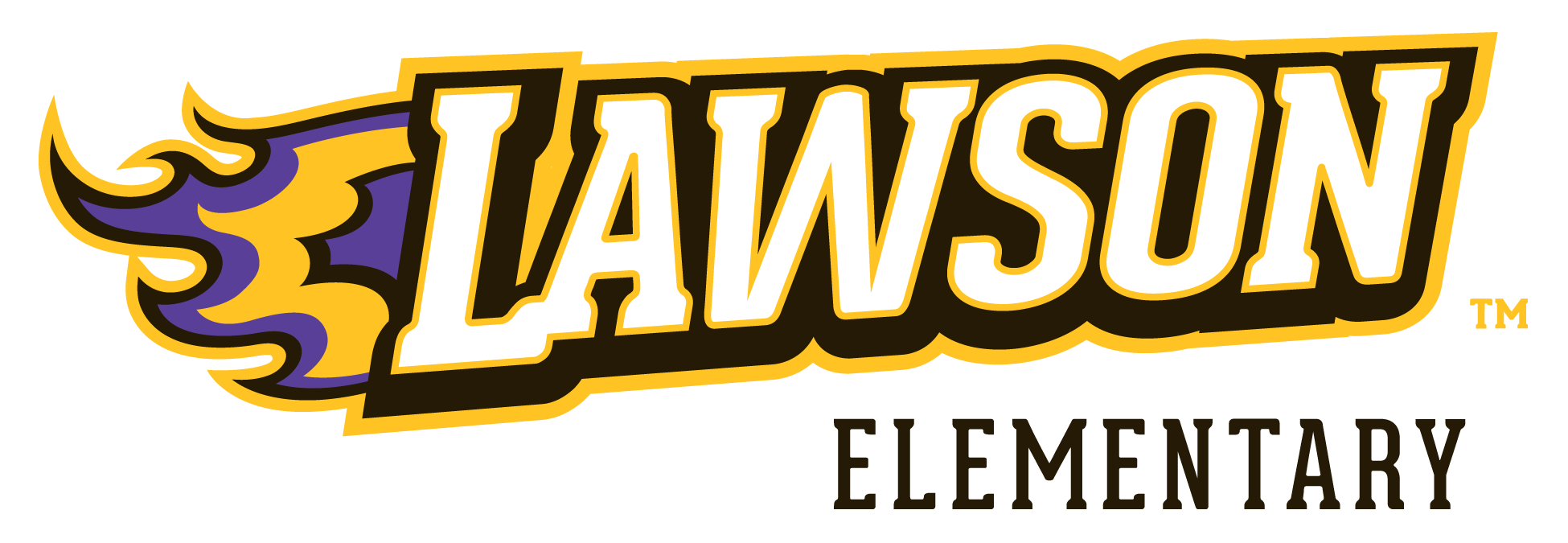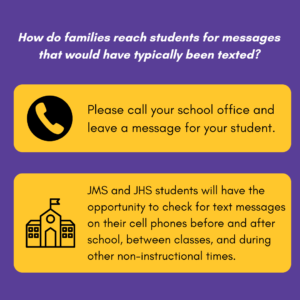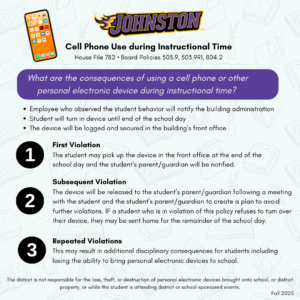Cell Phone Use during Instructional Time
A new state law, House File 782, restricts cell phone use in K-12 public schools during instructional time. The Johnston school board has updated its policies (503.9 Student Use of Personal Electronic Devices, 503.9R1 Student Use of Personal Electronic Devices Regulation, and 804.2 District Emergency Operations Plans) to be in alignment with the new law.
Prior to 2025-2026, the Johnston Community School District already had a full school day ban on cell phones at Summit Middle School and all five elementary schools (grades K-7), while Johnston Middle School and Johnston High School (grades 8-12) have had no cell phone use in class unless directed by the teacher.
Frequently Asked Questions
Q: How do families reach students for messages that would have typically been texted?
A: Please call your school office and leave a message for your student. JMS and JHS students will also have the opportunity to check for text messages on their cell phones before and after school, between classes, and during other non-instructional times.
Q: What are the consequences of using a cell phone or other personal electronic device during instructional time?
A: If a student is observed using a personal electronic device during instructional time, the employee who observed the student behavior will notify the building administration, who will require the student to turn in the device for safekeeping until the end of the school day. The device will be logged and secured in the building’s front office. The district is not responsible for the loss, theft, or destruction of personal electronic devices brought onto school, or district property, or while the student is attending district or school-sponsored events.
- For a student’s first violation, the student may pick up the device in the front office at the end of the school day and the student’s parent/guardian will be notified.
- For subsequent violations of this policy in a school year, the device will be released to the student’s parent/guardian following a meeting with the student and the student’s parent/guardian to create a plan to avoid further violations. IF a student who is in violation of this policy refuses to turn over their device, they may be sent home for the remainder of the school day.
- Repeated violations of this policy may result in additional disciplinary consequences for students including losing the ability to bring personal electronic devices to school.
Q: What are exceptions to the rule of not using personal electronic devices during instructional time?
A: A legitimate reason that is specifically authorized under current Individual Education Plan, 504 Plan or tied to a multi-tiered system of support (MTSS) Tier 2-3 interventions.
Q: What about in the event of an emergency?
A: When the district has deemed it safe to do so, students may contact their parents via personal electronic devices.
Q: What is considered a personal electronic device?
A: Any device used by a student to send or receive information or create or review content.
- This includes cellular and mobile phones, watches, or other wearable devices in a receive and transmit mode, laptop or notebook computers, tablets, video game devices, portable media players, earbuds or headphones (unless otherwise directed for instructional purposes), and any application or programs installed by a student on a school-owned or issued device.
- Students may wear smart or electronic watches, but may not use any communication applications or features that are prohibited from use on other electronic devices and all notifications must be turned off.
Q: What is considered instructional time?
A: Instructional time is defined differently by school building.
- In grades K-7, instructional time is defined as the beginning of the school day until the end of the school day, including lunch, passing periods and recess.
- In grades 8-12, instructional time is defined as periods of instruction from the beginning of class bell until the end of class bell including study hall. Open campus periods for students in grades 11-12 are not considered instructional time.


